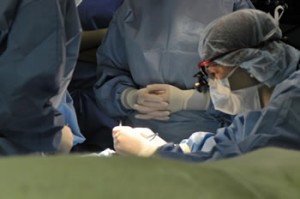
Jacqueline W. Pearce, DVM, MS, assistant teaching professor of comparative ophthalmology at the Veterinary Health Center, removes a rare melanoma from the eye of a young Missouri Fox Trotter.
For Angel, a 4-year-old Missouri Fox Trotter, the options appeared limited. At the urging of a friend who operates the ranch where the young horse is boarded, Angel’s owner, Laurie McCarthy of Bentonville, Ark., took her horse to a local veterinarian for what she suspected was a blood clot in Angel’s eye. The veterinarian’s diagnosis was far worse. McCarthy was told that Angel’s eye was afflicted with a tumor of the iris, which was suspected to be a rare malignant melanoma.
The usual treatment to prevent the potentially deadly cancer from spreading and save an animal’s life is removal of the eye. However, McCarthy remained hopeful that another solution could be found.
“She’s a young horse and she’s very smart,” McCarthy said of Angel, whom she had recently started training. “She picks things up quickly. I wanted her to have the best chance to be a well-rounded horse.”

Alison LaCarrubba, DVM, assistant teaching professor of equine medicine at the MU VMTH, monitors Angel’s recovery after surgery.
McCarthy and her friend Rebecca Christians brought Angel to the University of Missouri Veterinary Health Center to learn if Angel would be a candidate for treatment other than excision of her eye. Dr. Jacqueline Pearce, a veterinary ophthalmologist, attempted to treat the tumor using a laser procedure. However, the horse’s blue eye pigment prevented the procedure, which has been successful in dogs, cats and brown-eyed horses, from working.
Undeterred, McCarthy returned to Columbia two weeks later with Angel ready to take another chance. Pearce had agreed to try to surgically remove the cancerous tumor while attempting to save the eye. While melanomas are not uncommon in the eyes of dogs and cats, they are rare in horses. There had been only one documented case in which a melanoma was removed and the horse’s eye saved. The procedure had never been attempted at the MU VMTH.
McCarthy said she knew there was a chance the procedure would not succeed and that long-term preservation of Angel’s vision was far from certain, but thought it was important to try, not only for Angel’s sake, but also to help veterinary students expand their knowledge.
“If there was any way possible this would help other horses by providing a learning opportunity, I thought that was important,” she said.
Pearce said she began researching the surgical procedure and contacted the veterinary ophthalmologist in Florida who had successfully performed it on a young horse to learn from his experience.
“There was a high risk of excessive bleeding,” Pearce explained. “The eye could fill with blood and we could lose our chance to save vision. We knew there was a high likelihood of complications.”
Pearce said the use of electrocautery to control bleeding, delicate surgical technique, and sophisticated surgical instruments unique to MU, allowed her to remove the tumor during a 90-minute procedure.
The surgery initially appeared to succeed, but Angel was not in the clear yet. During recovery, she stumbled and banged her head against her stall, injuring her vulnerable eye that had just undergone surgery.
“Her eye filled up with blood. Fortunately, within 48 hours the bleeding had cleared and she could see again,” Pearce said.
Pearce said she treats all species, but most of her work focuses on small animals and some raptors. She credited a team approach, in which she was able to attend just to Angel’s eye while the VMTH equine veterinarians and technicians cared for the horse pre- and post-surgery for the success of Angel’s operation.
“She is visual and she is comfortable, and those are our two main goals; so we consider this a success,” Pearce said.



